Author:
Gregory Harris
Date Of Creation:
8 August 2021
Update Date:
1 July 2024

Content
- Steps
- Part 1 of 3: Popular home remedies
- Part 2 of 3: Herbal Remedies
- Part 3 of 3: Medical Assistance
- Tips
- Warnings
- Additional articles
Warts are benign (noncancerous) growths on the skin. They can appear on the palms and most other areas of the body, including the face, feet, and genitals. Regardless of where it occurs, warts are caused by the human papillomavirus (HPV), which enters the skin through small cuts and abrasions. Warts are contagious and can be spread by touch, especially if the immune system is weakened. Getting rid of warts on the palms can be tricky, although there are some fairly effective home remedies available. If these remedies do not work, see your doctor.
Steps
Part 1 of 3: Popular home remedies
 1 Rub a pumice stone over the wart. A quick and cheap way to get warts off your palms is to rub them with a pumice stone.Pumice is a natural abrasive and can be used to remove the top layer of a wart, especially if it has a thick, hardened crust. While pumice stone will erase the top layer, it does not remove the deeper "roots" of the wart below the surface of the skin, so it should be used in combination with a wart ointment.
1 Rub a pumice stone over the wart. A quick and cheap way to get warts off your palms is to rub them with a pumice stone.Pumice is a natural abrasive and can be used to remove the top layer of a wart, especially if it has a thick, hardened crust. While pumice stone will erase the top layer, it does not remove the deeper "roots" of the wart below the surface of the skin, so it should be used in combination with a wart ointment. - Soak your hand in warm water for about 15 minutes before rubbing the wart with a pumice stone to soften the skin.
- Be careful when using a pumice stone to remove small warts that are not covered with keratinized layers. In this case, you can scratch the skin until it bleeds. For smaller, softer warts, it is more convenient to use a small nail file.
- Do not rub warts on the palms and feet with a pumice stone in case of diabetes mellitus or peripheral neuropathy, since in these diseases the sensitivity of these places is weakened, which can lead to tissue damage.
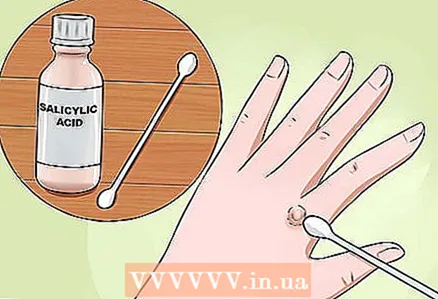 2 Apply salicylic acid to the wart. Another way to remove the top layers of a wart is to use salicylic acid. This acid dissolves the keratin protein that makes up the thickened upper layers of the wart. However, salicylic acid can damage or irritate the healthy skin around the wart, so be careful not to apply liquid, ointment, gel, or acid patch more than twice a day. Before applying salicylic acid, dampen your skin with warm water and rub the wart with a pumice stone or a nail file as described above - this will then penetrate deeper. For greater effect, apply a bandage overnight. Removing a large wart with salicylic acid can take weeks, so be patient.
2 Apply salicylic acid to the wart. Another way to remove the top layers of a wart is to use salicylic acid. This acid dissolves the keratin protein that makes up the thickened upper layers of the wart. However, salicylic acid can damage or irritate the healthy skin around the wart, so be careful not to apply liquid, ointment, gel, or acid patch more than twice a day. Before applying salicylic acid, dampen your skin with warm water and rub the wart with a pumice stone or a nail file as described above - this will then penetrate deeper. For greater effect, apply a bandage overnight. Removing a large wart with salicylic acid can take weeks, so be patient. - Salicylic acid and warts with it can be purchased without a prescription at your local pharmacy. Some products also contain dichloroacetic acid and trichloroacetic acid, which burn off warts.
- In most cases, a 17% salicylic acid solution or a 15% wart patch is suitable for removing warts on the palms.
- Remember that sometimes the warts on the palms will go away on their own thanks to the work of the immune system, so you can just wait a few weeks and see what happens next.
 3 Try cryotherapy. With cryotherapy (cold treatment), the warts are frozen. This common procedure for removing warts is often used by therapists and dermatologists, and there are over-the-counter liquid nitrogen products (such as Cryopharma or Dr. Scholl's Freeze Away) that you can use on your own at home. After applying liquid nitrogen to the wart, a blister forms, and then after about a week, it falls off along with the wart. Repeated treatments are necessary to prevent the wart from regrowing. For a more effective liquid nitrogen treatment, scrub the wart with a pumice stone or nail file before applying it.
3 Try cryotherapy. With cryotherapy (cold treatment), the warts are frozen. This common procedure for removing warts is often used by therapists and dermatologists, and there are over-the-counter liquid nitrogen products (such as Cryopharma or Dr. Scholl's Freeze Away) that you can use on your own at home. After applying liquid nitrogen to the wart, a blister forms, and then after about a week, it falls off along with the wart. Repeated treatments are necessary to prevent the wart from regrowing. For a more effective liquid nitrogen treatment, scrub the wart with a pumice stone or nail file before applying it. - Cryotherapy can cause minor pain. In case of severe pain, discontinue the procedure and consult a doctor.
- Liquid nitrogen can cause scars on healthy light skin or dark spots on dark skin, so be careful when applying it.
- Ice and cooling gel packs are also types of cryotherapy that can be used to treat damage to bones and muscles, but do not use them to remove warts. They are ineffective and can lead to frostbite of the skin.
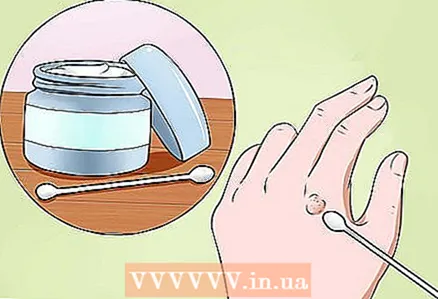 4 Use ointments. There are many over-the-counter ointments that can help get rid of warts, and they are usually less painful than cryotherapy. These ointments destroy the structure of the warts at a chemical level and completely remove the warts. Typically, they contain dichloroacetic and trichloroacetic acids, 5-fluorouracil, zinc oxide, or a small amount of a retinoid (vitamin A derivative).Apply the ointment to the wart in the palm of your hand, rub it and wait about five minutes for it to absorb, then wash your hands.
4 Use ointments. There are many over-the-counter ointments that can help get rid of warts, and they are usually less painful than cryotherapy. These ointments destroy the structure of the warts at a chemical level and completely remove the warts. Typically, they contain dichloroacetic and trichloroacetic acids, 5-fluorouracil, zinc oxide, or a small amount of a retinoid (vitamin A derivative).Apply the ointment to the wart in the palm of your hand, rub it and wait about five minutes for it to absorb, then wash your hands. - Instead of ointment, you can use tampons for warts. They work like ointments. You can rub the wart with a medicated tampon, or place a small piece of the tampon on it for about an hour and secure it in place with a medical tape or adhesive bandage.
- Retinoids are commonly used to slow down the effects of aging, but they can also remove dead skin cells from the face and thereby unclog pores. This also applies to warts.
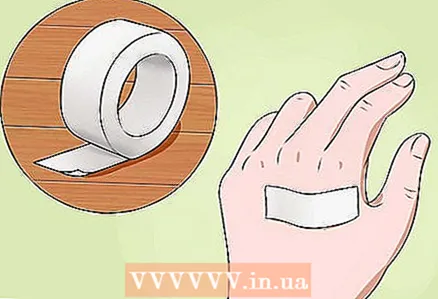 5 Place scotch tape on the wart. There is a lot of evidence (and some scientific studies) that applying regular tape to warts is quite effective, although how it works is not entirely clear. In a 2002 study, it was found that 85% of people who used scotch tape got rid of warts within a month, and this method was more effective than cryotherapy. So try sticking tape on the wart in the palm of your hand, then peel it off, remove the dead tissue with a pumice stone or a nail file, and watch to see if the wart grows back. You can repeat this procedure several times. The good thing about this method is that it is cheap and has no unpleasant side effects.
5 Place scotch tape on the wart. There is a lot of evidence (and some scientific studies) that applying regular tape to warts is quite effective, although how it works is not entirely clear. In a 2002 study, it was found that 85% of people who used scotch tape got rid of warts within a month, and this method was more effective than cryotherapy. So try sticking tape on the wart in the palm of your hand, then peel it off, remove the dead tissue with a pumice stone or a nail file, and watch to see if the wart grows back. You can repeat this procedure several times. The good thing about this method is that it is cheap and has no unpleasant side effects. - Wipe the skin with rubbing alcohol, then gently tape a small piece of tape onto the wart. Leave it on for 24 hours, then replace it with a fresh piece of scotch tape. Repeat this procedure once a week for up to six weeks if necessary.
- Some people believe that other types of thick adhesive tape, such as duct tape, can be used instead of tape for this purpose, but this issue has not been investigated.
- Some people use objects such as banana peels or potato peels to try to get rid of warts.
Part 2 of 3: Herbal Remedies
 1 Use apple cider vinegar. Apple cider vinegar has long been a home remedy used to remove blemishes from skin, including warts. Vinegar contains citric acid and a large amount of acetic acid. These acids have antiviral effects (they kill HPV and some other viruses). However, citric acid and acetic acid can also irritate healthy skin, so be careful. Try soaking a cotton ball or cotton swab in vinegar and gently applying it to the top of the wart, then cover the wart with a bandage overnight. Repeat this procedure every day. After about a week, the wart should darken and then fall off. Soon this place will be covered with healthy skin.
1 Use apple cider vinegar. Apple cider vinegar has long been a home remedy used to remove blemishes from skin, including warts. Vinegar contains citric acid and a large amount of acetic acid. These acids have antiviral effects (they kill HPV and some other viruses). However, citric acid and acetic acid can also irritate healthy skin, so be careful. Try soaking a cotton ball or cotton swab in vinegar and gently applying it to the top of the wart, then cover the wart with a bandage overnight. Repeat this procedure every day. After about a week, the wart should darken and then fall off. Soon this place will be covered with healthy skin. - At first, apple cider vinegar may cause a slight burning sensation or slight swelling of the skin around the wart, but these symptoms usually go away soon.
- Another possible downside to apple cider vinegar is that it smells bad for most people.
- White vinegar also contains acetic acid, however, unlike apple cider vinegar, it does not appear to have an effect on warts.
 2 Try applying garlic extract to the wart. Garlic is another long-standing home remedy that has been used to treat many ailments. Garlic contains the organic compound allicin, which has a strong antimicrobial effect and kills many microorganisms, including HPV. In a 2005 study, it was found that garlic extract can completely get rid of warts in a few weeks, after which they did not reappear for many months. Rubbed raw garlic or commercially available garlic extract can be applied directly to the wart in the palm of your hand several times a day for 1 to 2 weeks. After application, cover the wart with a bandage for a few hours, then you can apply fresh garlic. It is best to apply the garlic before bed so that the allicin is absorbed deep into the wart during the night.
2 Try applying garlic extract to the wart. Garlic is another long-standing home remedy that has been used to treat many ailments. Garlic contains the organic compound allicin, which has a strong antimicrobial effect and kills many microorganisms, including HPV. In a 2005 study, it was found that garlic extract can completely get rid of warts in a few weeks, after which they did not reappear for many months. Rubbed raw garlic or commercially available garlic extract can be applied directly to the wart in the palm of your hand several times a day for 1 to 2 weeks. After application, cover the wart with a bandage for a few hours, then you can apply fresh garlic. It is best to apply the garlic before bed so that the allicin is absorbed deep into the wart during the night. - As with apple cider vinegar, garlic can cause a slight burning sensation or slight swelling of the skin around the wart, but this goes away quickly. And of course, remember that garlic has a strong odor.
- As a less effective alternative, oral garlic powder capsules can be taken, which acts on HPV through the bloodstream.
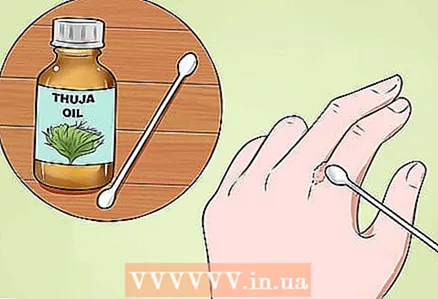 3 Consider using thuja oil. Thuja oil is obtained from the needles and roots of thuja folded (Canadian red cedar). This ancient Ayurvedic remedy is used to treat many diseases due to its strong antiviral properties - it contains compounds that stimulate the immune system and thereby help destroy viruses, including HPV. Therefore, thuja oil can be used to remove all types of warts. Apply thuja oil directly to the wart and wait about 5 minutes for it to absorb, then cover the wart with a bandage. Repeat the procedure twice a day for 2 weeks. Thuja oil is powerful and can easily irritate the surrounding skin, so be careful.
3 Consider using thuja oil. Thuja oil is obtained from the needles and roots of thuja folded (Canadian red cedar). This ancient Ayurvedic remedy is used to treat many diseases due to its strong antiviral properties - it contains compounds that stimulate the immune system and thereby help destroy viruses, including HPV. Therefore, thuja oil can be used to remove all types of warts. Apply thuja oil directly to the wart and wait about 5 minutes for it to absorb, then cover the wart with a bandage. Repeat the procedure twice a day for 2 weeks. Thuja oil is powerful and can easily irritate the surrounding skin, so be careful. - To reduce the risk of skin irritation, try diluting the thuja oil with a small amount of mineral oil or fish oil before applying.
- Thuja oil is usually recommended for removing particularly stubborn warts that do not lend themselves to other methods - this is a kind of last resort.
- Thuja is also included in homeopathic tablets that can be placed under the tongue several times a day. These small tablets are tasteless and contain negligible amounts of thuja extract. However, they can be beneficial and have no side effects.
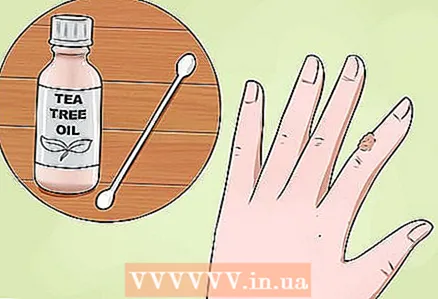 4 Don't forget about tea tree oil. This oil is an extract of tea tree leaves (Melaleuca Alternifolia). It can be helpful in treating warts and other skin blemishes due to its strong antimicrobial and antiviral properties that help kill HPV. However, it appears that tea tree oil does not penetrate warts as well as apple cider vinegar, garlic extract, or thuja oil. However, tea tree oil also strengthens the immune system when taken internally, which helps prevent re-infection with HPV. To get started, try applying 2-3 drops of tea tree essential oil to the wart in the palm of your hand 2 times a day for at least 3-4 weeks and see if it helps. For greater effect, you can first rub the protruding part of the wart with a pumice stone or a nail file.
4 Don't forget about tea tree oil. This oil is an extract of tea tree leaves (Melaleuca Alternifolia). It can be helpful in treating warts and other skin blemishes due to its strong antimicrobial and antiviral properties that help kill HPV. However, it appears that tea tree oil does not penetrate warts as well as apple cider vinegar, garlic extract, or thuja oil. However, tea tree oil also strengthens the immune system when taken internally, which helps prevent re-infection with HPV. To get started, try applying 2-3 drops of tea tree essential oil to the wart in the palm of your hand 2 times a day for at least 3-4 weeks and see if it helps. For greater effect, you can first rub the protruding part of the wart with a pumice stone or a nail file. - Tea tree oil has been used for centuries in Australia and New Zealand. It has become popular in the West for the past 10 years.
- In very rare cases, tea tree oil can irritate the skin and cause an allergic reaction in some people with sensitive skin.
Part 3 of 3: Medical Assistance
 1 Consult your doctor. If the wart in the palm of your hand does not go away on its own or after using the above home remedies, make an appointment with your doctor. This is especially worth doing if the wart hurts or is located in the most inappropriate place. Your doctor will examine your palm to make sure it is just a wart and not some other skin condition. In appearance, warts can resemble skin problems such as calluses, calluses, moles, hair ingrown into the skin, acne, blisters, seborrheic keratosis, lichen planus, squamous cell carcinoma. To make sure it's not something more serious, like skin cancer, your doctor may do a biopsy, which means taking a tissue sample and examining it under a microscope.
1 Consult your doctor. If the wart in the palm of your hand does not go away on its own or after using the above home remedies, make an appointment with your doctor. This is especially worth doing if the wart hurts or is located in the most inappropriate place. Your doctor will examine your palm to make sure it is just a wart and not some other skin condition. In appearance, warts can resemble skin problems such as calluses, calluses, moles, hair ingrown into the skin, acne, blisters, seborrheic keratosis, lichen planus, squamous cell carcinoma. To make sure it's not something more serious, like skin cancer, your doctor may do a biopsy, which means taking a tissue sample and examining it under a microscope. - If you don't have a wart in your hand, your doctor may refer you to a skin specialist (dermatologist) who will prescribe treatment.
- If the mass in the palm of your hand turns out to be a common wart, your doctor will most likely perform cryotherapy (a stronger method than over-the-counter medications).Your doctor may apply a local anesthetic before applying liquid nitrogen to the wart.
- If cryotherapy is performed by a doctor, there should be no scars on the skin after it. New skin will grow at the site of the removed wart and fill the remaining cavity.
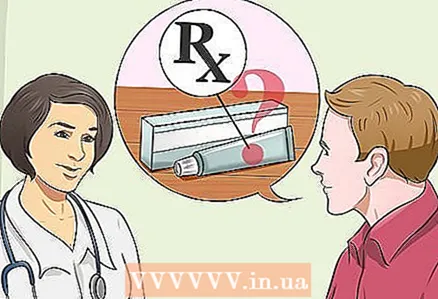 2 Ask your doctor about more powerful prescription drugs. If you or your doctor are not inclined to perform cryotherapy, ask them to prescribe suitable topical medications that are more potent than over-the-counter creams and ointments. For example, prescription drugs have a salicylic acid concentration of 27.5% or more, so they are more effective (but also more dangerous to use) than over-the-counter drugs that contain less than 17% salicylic acid. Another prescription topical treatment for warts (especially on the soles of the feet) is cantharidin, a substance obtained from Spanish flies. Cantharidin is a powerful poison that burns out warts. It is often used in combination with salicylic acid.
2 Ask your doctor about more powerful prescription drugs. If you or your doctor are not inclined to perform cryotherapy, ask them to prescribe suitable topical medications that are more potent than over-the-counter creams and ointments. For example, prescription drugs have a salicylic acid concentration of 27.5% or more, so they are more effective (but also more dangerous to use) than over-the-counter drugs that contain less than 17% salicylic acid. Another prescription topical treatment for warts (especially on the soles of the feet) is cantharidin, a substance obtained from Spanish flies. Cantharidin is a powerful poison that burns out warts. It is often used in combination with salicylic acid. - Studies have confirmed that salicylic acid is more effective when combined with cryotherapy.
- Prescription drugs containing salicylic acid are often taken to patients at home, but they are dangerous and can cause severe skin irritation and scarring.
- On the other hand, cantharidin is poisonous if swallowed, which is why it is usually used in stationary conditions.
 3 Consider the possibility of laser therapy. Emerging technologies have provided healthcare professionals with another effective remedy for skin blemishes such as warts. For example, a pulsed dye laser can burn out and destroy (or cauterize) the tiny blood vessels that surround and feed a wart, causing the wart to die off and fall off. Other, more traditional types of lasers can burn off the wart itself in minutes, although this will require local anesthesia. This procedure does not require hospitalization and only slightly irritates the surrounding skin.
3 Consider the possibility of laser therapy. Emerging technologies have provided healthcare professionals with another effective remedy for skin blemishes such as warts. For example, a pulsed dye laser can burn out and destroy (or cauterize) the tiny blood vessels that surround and feed a wart, causing the wart to die off and fall off. Other, more traditional types of lasers can burn off the wart itself in minutes, although this will require local anesthesia. This procedure does not require hospitalization and only slightly irritates the surrounding skin. - The use of pulsed dye lasers has a 95% success rate for all types of warts, and they very rarely reappear.
- Be aware that laser therapy for warts and other skin blemishes can be quite expensive, so check with your health insurance to see if it is available. Warts on the palms are not considered a serious medical condition, so you may have to pay in full for the procedure out of your own pocket.
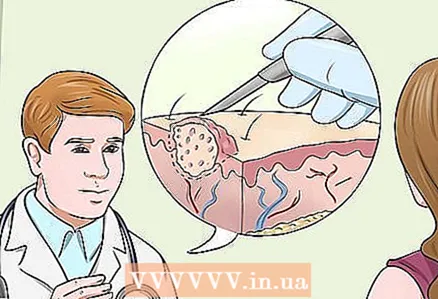 4 As a last resort, talk with your doctor about surgery. If home remedies and other treatments have failed to clear up the wart, talk to your doctor about having it surgically removed. Removing warts is considered an easy operation that does not require hospitalization. In this case, the wart is cut out with a scalpel, or removed using an electric or ultrasonic device (the so-called fulguration and scraping). During fulguration, the tissues of the wart itself are destroyed, and scraping consists in removing dead tissue using a special metal instrument - a curette. This is a painful procedure that requires local anesthesia.
4 As a last resort, talk with your doctor about surgery. If home remedies and other treatments have failed to clear up the wart, talk to your doctor about having it surgically removed. Removing warts is considered an easy operation that does not require hospitalization. In this case, the wart is cut out with a scalpel, or removed using an electric or ultrasonic device (the so-called fulguration and scraping). During fulguration, the tissues of the wart itself are destroyed, and scraping consists in removing dead tissue using a special metal instrument - a curette. This is a painful procedure that requires local anesthesia. - Keep in mind that surgical removal of the wart usually leaves a scar.
- After some time after electrofulguration, the wart may grow back at the site of the remaining scar.
- When a deep wart is excised, it can sometimes spread to nearby tissues, especially in the case of a weakened immune system.
Tips
- Warts of all kinds can be contagious, so avoid bodily contact with people and try not to touch other parts of your body with an infected palm.
- Do not use the pumice stone you used to rub the wart on other areas of your body.
- Wash your hands thoroughly every time you touch your own warts or other people's warts.
Warnings
- Pay attention to growths and other changes in your skin. Some lesions may not be warts and may require immediate medical attention. If you are concerned about something or notice something suspicious, see your doctor.
Additional articles
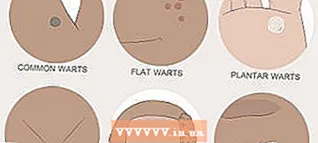 How to get rid of warts
How to get rid of warts 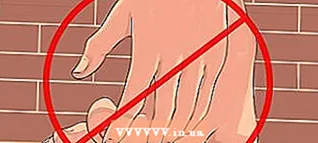 How to get rid of a plantar wart
How to get rid of a plantar wart  How to get rid of genital warts
How to get rid of genital warts 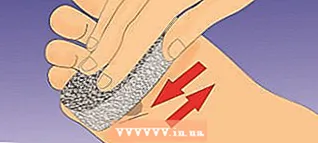 How to get rid of warts on the bottom of your feet
How to get rid of warts on the bottom of your feet 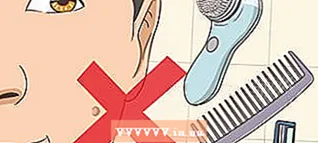 How to get rid of facial warts
How to get rid of facial warts  How to treat genital warts for a man
How to treat genital warts for a man 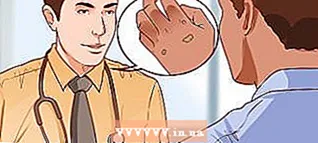 How to remove a wart with garlic
How to remove a wart with garlic 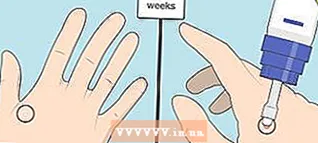 How to freeze warts with liquid nitrogen
How to freeze warts with liquid nitrogen 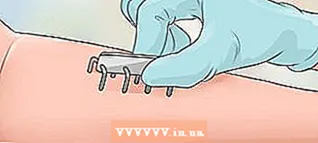 How to get rid of acne on the buttocks
How to get rid of acne on the buttocks  How to treat sunburn blisters
How to treat sunburn blisters  How to get rid of itchy skin with home remedies
How to get rid of itchy skin with home remedies  How to get rid of pimples overnight
How to get rid of pimples overnight 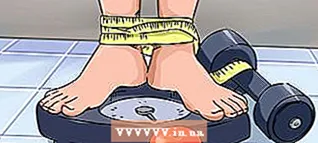 How to heal chapped skin
How to heal chapped skin 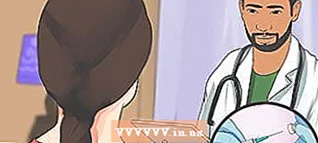 How to get rid of pimples around lips quickly
How to get rid of pimples around lips quickly



